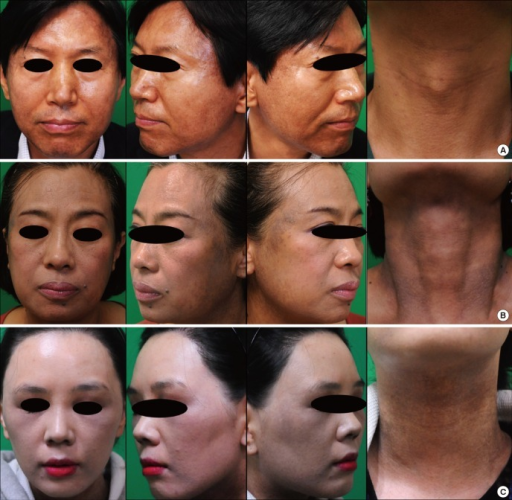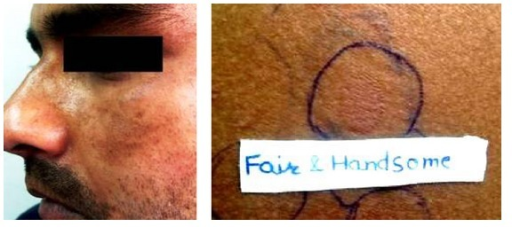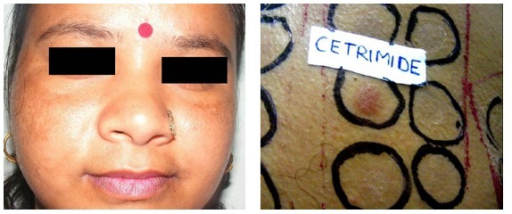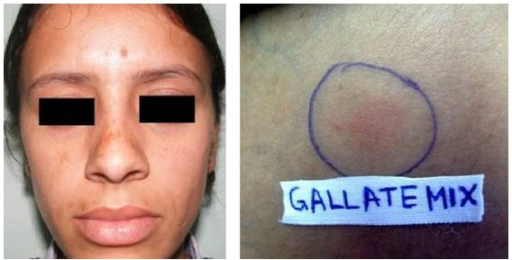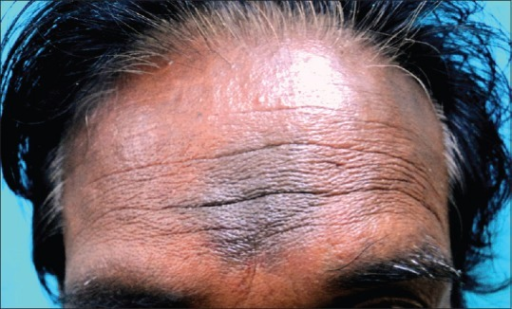[1]
Ding Y, Xu Z, Xiang LF, Zhang C. Unveiling the mystery of Riehl's melanosis: An update from pathogenesis, diagnosis to treatment. Pigment cell & melanoma research. 2023 Nov:36(6):455-467. doi: 10.1111/pcmr.13108. Epub 2023 Jul 4
[PubMed PMID: 37401632]
[2]
Shah S, Baskaran N, Vinay K, Bishnoi A, Parsad D, Kumaran MS. Acquired dermal macular hyperpigmentation: an overview of the recent updates. International journal of dermatology. 2023 Dec:62(12):1447-1457. doi: 10.1111/ijd.16859. Epub 2023 Sep 28
[PubMed PMID: 37767951]
Level 3 (low-level) evidence
[3]
Sitohang IBS, Prayogo RL, Rihatmadja R, Sirait SP. The diagnostic conundrum of Riehl melanosis and other facial pigmentary disorders: a case report with overlapping clinical, dermoscopic, and histopathological features. Acta dermatovenerologica Alpina, Pannonica, et Adriatica. 2020 Jun:29(2):81-83
[PubMed PMID: 32566956]
Level 3 (low-level) evidence
[4]
Xu L, Huang Q, Wu T, Mu Y. Research Advances in the Treatment of Riehl's Melanosis. Clinical, cosmetic and investigational dermatology. 2023:16():1181-1189. doi: 10.2147/CCID.S403090. Epub 2023 May 4
[PubMed PMID: 37168093]
Level 3 (low-level) evidence
[5]
Vinay K, Bishnoi A, Parsad D, Saikia UN, Sendhil Kumaran M. Dermatoscopic evaluation and histopathological correlation of acquired dermal macular hyperpigmentation. International journal of dermatology. 2017 Dec:56(12):1395-1399. doi: 10.1111/ijd.13782. Epub 2017 Oct 3
[PubMed PMID: 28971471]
[7]
Nakayama H, Matsuo S, Hayakawa K, Takhashi K, Shigematsu T, Ota S. Pigmented cosmetic dermatitis. International journal of dermatology. 1984 Jun:23(5):299-305
[PubMed PMID: 6746179]
[8]
Wang RF, Ko D, Friedman BJ, Lim HW, Mohammad TF. Disorders of hyperpigmentation. Part I. Pathogenesis and clinical features of common pigmentary disorders. Journal of the American Academy of Dermatology. 2023 Feb:88(2):271-288. doi: 10.1016/j.jaad.2022.01.051. Epub 2022 Feb 11
[PubMed PMID: 35151757]
[9]
Sarkar R, Vinay K, Bishnoi A, Poojary S, Gupta M, Kumaran MS, Jain A, Gurumurthy C, Arora P, Kandhari R, Rathi S, Zawar V, Gupta V, Ravivarma VN, Rodrigues M, Parsad D. A Delphi consensus on the nomenclature and diagnosis of lichen planus pigmentosus and related entities. Indian journal of dermatology, venereology and leprology. 2023 Jan-Frebuary:89(1):41-46. doi: 10.25259/IJDVL_804_2021. Epub
[PubMed PMID: 35593293]
Level 3 (low-level) evidence
[10]
Lai K, Zheng X, Wei S, Zhou H, Zeng X, Liang G, Zhang Z, Zhang W. Coexistence of Riehl's Melanosis, Lupus Erythematosus and Thyroiditis in a Patient. Clinical, cosmetic and investigational dermatology. 2022:15():1809-1813. doi: 10.2147/CCID.S376614. Epub 2022 Sep 8
[PubMed PMID: 36105748]
[11]
Jung JM, Noh TK, Jo SY, Kim SY, Song Y, Kim YH, Chang SE. Guanine Deaminase in Human Epidermal Keratinocytes Contributes to Skin Pigmentation. Molecules (Basel, Switzerland). 2020 Jun 5:25(11):. doi: 10.3390/molecules25112637. Epub 2020 Jun 5
[PubMed PMID: 32517074]
[12]
Xu Z, Chen L, Jiang M, Wang Q, Zhang C, Xiang LF. CCN1/Cyr61 Stimulates Melanogenesis through Integrin α6β1, p38 MAPK, and ERK1/2 Signaling Pathways in Human Epidermal Melanocytes. The Journal of investigative dermatology. 2018 Aug:138(8):1825-1833. doi: 10.1016/j.jid.2018.02.029. Epub 2018 Mar 3
[PubMed PMID: 29510193]
[13]
Woo YR, Kim JS, Lim JH, Choi JY, Kim M, Yu DS, Park YM, Park HJ. Acquired diffuse slate-grey facial dyspigmentation due to henna: an unrecognized cause of pigment contact dermatitis in Korean patients. European journal of dermatology : EJD. 2018 Oct 1:28(5):644-648. doi: 10.1684/ejd.2018.3404. Epub
[PubMed PMID: 30530434]
[14]
Sugai T, Takahashi Y, Takagi T. Pigmented cosmetic dermatitis and coal tar dyes. Contact dermatitis. 1977 Oct:3(5):249-56
[PubMed PMID: 589997]
[15]
Lu Q, Jiang G. Progress in the application of reflectance confocal microscopy in dermatology. Postepy dermatologii i alergologii. 2021 Oct:38(5):709-715. doi: 10.5114/ada.2021.110077. Epub 2021 Nov 5
[PubMed PMID: 34849113]
[16]
Kim NH, Lee AY. Growth Factors Upregulated by Uric Acid Affect Guanine Deaminase-Induced Melanogenesis. Biomolecules & therapeutics. 2023 Jan 1:31(1):89-96. doi: 10.4062/biomolther.2022.137. Epub 2022 Dec 22
[PubMed PMID: 36549672]
[17]
Miyoshi K, Kodama H. Riehl's melanosis-like eruption associated with Sjögren's syndrome. The Journal of dermatology. 1997 Dec:24(12):784-6
[PubMed PMID: 9492444]
[18]
Takeo N, Sakai T, Saito-Shono T, Ishikawa K, Hatano Y, Katagiri K, Takahashi Y, Kawano K, Kimoto K, Kubota T, Eshima N, Kojima H, Fujiwara S. Three cases of pigmented cosmetic dermatitis-like eruptions associated with primary Sjögren's syndrome or anti-SSA antibody. The Journal of dermatology. 2016 Aug:43(8):947-50. doi: 10.1111/1346-8138.13300. Epub 2016 Feb 19
[PubMed PMID: 26892480]
Level 3 (low-level) evidence
[19]
Vinay K, Bishnoi A, Kamat D, Chatterjee D, Kumaran MS, Parsad D. Acquired Dermal Macular Hyperpigmentation: An Update. Indian dermatology online journal. 2021 Sep-Oct:12(5):663-673. doi: 10.4103/idoj.IDOJ_881_20. Epub 2021 Aug 2
[PubMed PMID: 34667751]
[20]
Khanna N, Rasool S. Facial melanoses: Indian perspective. Indian journal of dermatology, venereology and leprology. 2011 Sep-Oct:77(5):552-63; quiz 564. doi: 10.4103/0378-6323.84046. Epub
[PubMed PMID: 21860153]
Level 3 (low-level) evidence
[21]
Serrano G, Pujol C, Cuadra J, Gallo S, Aliaga A. Riehl's melanosis: pigmented contact dermatitis caused by fragrances. Journal of the American Academy of Dermatology. 1989 Nov:21(5 Pt 2):1057-60
[PubMed PMID: 2808836]
[22]
Shenoi SD, Rao R. Pigmented contact dermatitis. Indian journal of dermatology, venereology and leprology. 2007 Sep-Oct:73(5):285-7
[PubMed PMID: 17921604]
[23]
Pérez-Bernal A, Muñoz-Pérez MA, Camacho F. Management of facial hyperpigmentation. American journal of clinical dermatology. 2000 Sep-Oct:1(5):261-8
[PubMed PMID: 11702317]
[24]
Kozuka T, Tashiro M, Sano S, Fujimoto K, Nakamura Y, Hashimoto S, Nakaminami G. Brilliant Lake Red R as a cause of pigmented contact dermatitis. Contact dermatitis. 1979 Sep:5(5):297-304
[PubMed PMID: 509931]
[25]
Woo YR, Jung Y, Jeong SW, Park HJ. Paracrine roles of hormone receptors in Riehl's melanosis: A quantitative analysis of oestrogen and progesterone receptor expression patterns. Experimental dermatology. 2021 Mar:30(3):396-401. doi: 10.1111/exd.14233. Epub 2020 Dec 10
[PubMed PMID: 33141431]
[26]
Kang HY. Melasma and aspects of pigmentary disorders in Asians. Annales de dermatologie et de venereologie. 2012 Dec:139 Suppl 4():S144-7. doi: 10.1016/S0151-9638(12)70126-6. Epub
[PubMed PMID: 23522629]
[27]
Woo YR, Jung Y, Kim M, Park HJ. Impact of Riehl's melanosis on quality of life in Korean patients: A cross-sectional comparative study. The Journal of dermatology. 2020 Aug:47(8):893-897. doi: 10.1111/1346-8138.15382. Epub 2020 Jun 26
[PubMed PMID: 32592174]
[28]
Farabi B, Khan S, Jamgochian M, Atak MF, Jain M, Rao BK. The role of reflectance confocal microscopy in the diagnosis and management of pigmentary disorders: A review. Journal of cosmetic dermatology. 2023 Dec:22(12):3213-3222. doi: 10.1111/jocd.15827. Epub 2023 Sep 27
[PubMed PMID: 37759421]
[29]
Kim SM, Lee ES, Sohn S, Kim YC. Histopathological Features of Riehl Melanosis. The American Journal of dermatopathology. 2020 Feb:42(2):117-121. doi: 10.1097/DAD.0000000000001515. Epub
[PubMed PMID: 31990700]
[31]
Lautenschlager S, Itin PH. Reticulate, patchy and mottled pigmentation of the neck. Acquired forms. Dermatology (Basel, Switzerland). 1998:197(3):291-6
[PubMed PMID: 9812039]
[32]
Shen PC, Chan YP, Huang CH, Ng CY. Riehl's Melanosis: A Multimodality, In Vivo, Real-Time Skin Imaging Study with Cellular Resolution Optical Coherence Tomography and Advanced Skin Diagnosis System in a Tertiary Medical Center. Bioengineering (Basel, Switzerland). 2022 Aug 26:9(9):. doi: 10.3390/bioengineering9090419. Epub 2022 Aug 26
[PubMed PMID: 36134965]
[33]
Krueger L, Saizan A, Stein JA, Elbuluk N. Dermoscopy of acquired pigmentary disorders: a comprehensive review. International journal of dermatology. 2022 Jan:61(1):7-19. doi: 10.1111/ijd.15741. Epub 2021 Jul 7
[PubMed PMID: 34235719]
[34]
Wang L, Xu AE. Four views of Riehl's melanosis: clinical appearance, dermoscopy, confocal microscopy and histopathology. Journal of the European Academy of Dermatology and Venereology : JEADV. 2014 Sep:28(9):1199-206. doi: 10.1111/jdv.12264. Epub 2013 Sep 7
[PubMed PMID: 24010902]
[35]
Kumaran MS, Dabas G, Vinay K, Parsad D. Reliability assessment and validation of the dermal pigmentation area and severity index: a new scoring method for acquired dermal macular hyperpigmentation. Journal of the European Academy of Dermatology and Venereology : JEADV. 2019 Jul:33(7):1386-1392. doi: 10.1111/jdv.15516. Epub 2019 Apr 15
[PubMed PMID: 30801771]
Level 1 (high-level) evidence
[36]
Akulinina I, Dodina M, Osadchuk M, Degtyarevskaya T. Optimizing diagnostic and therapeutic measures for different types of melasma based on the biophysical characteristics of facial skin. Journal of cosmetic and laser therapy : official publication of the European Society for Laser Dermatology. 2023 May 19:25(1-4):25-32. doi: 10.1080/14764172.2023.2230531. Epub 2023 Jul 2
[PubMed PMID: 37394829]
[37]
Sadaqat B, Khatoon N, Malik AY, Jamal A, Farooq U, Ali MI, He H, Liu FJ, Guo H, Urynowicz M, Wang Q, Huang Z. Enzymatic decolorization of melanin by lignin peroxidase from Phanerochaete chrysosporium. Scientific reports. 2020 Nov 19:10(1):20240. doi: 10.1038/s41598-020-76376-9. Epub 2020 Nov 19
[PubMed PMID: 33214596]
[38]
Draelos ZD. A split-face evaluation of a novel pigment-lightening agent compared with no treatment and hydroquinone. Journal of the American Academy of Dermatology. 2015 Jan:72(1):105-7. doi: 10.1016/j.jaad.2014.09.011. Epub 2014 Oct 16
[PubMed PMID: 25440437]
[39]
Zhong SM, Sun N, Liu HX, Niu YQ, Wu Y. Reduction of facial pigmentation of melasma by topical lignin peroxidase: A novel fast-acting skin-lightening agent. Experimental and therapeutic medicine. 2015 Feb:9(2):341-344
[PubMed PMID: 25574195]
[40]
Mauricio T, Karmon Y, Khaiat A. A randomized and placebo-controlled study to compare the skin-lightening efficacy and safety of lignin peroxidase cream vs. 2% hydroquinone cream. Journal of cosmetic dermatology. 2011 Dec:10(4):253-9. doi: 10.1111/j.1473-2165.2011.00581.x. Epub
[PubMed PMID: 22151932]
Level 1 (high-level) evidence
[41]
Xu Z, Xing X, Zhang C, Chen L, Flora Xiang L. A pilot study of oral tranexamic acid and Glycyrrhizin compound in the treatment of recalcitrant Riehl's melanosis. Journal of cosmetic dermatology. 2019 Feb:18(1):286-292. doi: 10.1111/jocd.12797. Epub 2018 Oct 19
[PubMed PMID: 30341831]
Level 3 (low-level) evidence
[42]
Li L, Ma Q, Li H. Effect of vitiligo treatment using compound glycyrrhizin combined with fractional carbon dioxide laser and topical triamcinolone acetonide on serum interleukin-17 and tissue growth factor-β levels. The Journal of international medical research. 2019 Nov:47(11):5623-5631. doi: 10.1177/0300060519871382. Epub 2019 Sep 25
[PubMed PMID: 31550958]
[43]
Mou KH, Han D, Liu WL, Li P. Combination therapy of orally administered glycyrrhizin and UVB improved active-stage generalized vitiligo. Brazilian journal of medical and biological research = Revista brasileira de pesquisas medicas e biologicas. 2016 Jul 25:49(8):. pii: S0100-879X2016000800605. doi: 10.1590/1414-431X20165354. Epub
[PubMed PMID: 27464024]
[44]
Størmer FC, Reistad R, Alexander J. Glycyrrhizic acid in liquorice--evaluation of health hazard. Food and chemical toxicology : an international journal published for the British Industrial Biological Research Association. 1993 Apr:31(4):303-12
[PubMed PMID: 8386690]
[45]
Bishnoi A, Vinay K, Parsad D, Kumar S, Chatterjee D, Nahar Saikia U, Sendhil Kumaran M. Oral mycophenolate mofetil in the treatment of acquired dermal macular hyperpigmentation: An open-label pilot study. The Australasian journal of dermatology. 2021 Aug:62(3):278-285. doi: 10.1111/ajd.13567. Epub 2021 Mar 4
[PubMed PMID: 33660856]
Level 3 (low-level) evidence
[46]
Rani S, Ahuja A. Chemical peel as an adjuvant treatment in pigmented contact dermatitis: a case series. Journal of cosmetic and laser therapy : official publication of the European Society for Laser Dermatology. 2022 Nov 17:24(6-8):112-117. doi: 10.1080/14764172.2022.2147953. Epub 2022 Nov 17
[PubMed PMID: 36384385]
Level 2 (mid-level) evidence
[47]
Wang L, Wen X, Hao D, Li Y, Du D, Jiang X. Combination therapy with salicylic acid chemical peels, glycyrrhizin compound, and vitamin C for Riehl's melanosis. Journal of cosmetic dermatology. 2020 Jun:19(6):1377-1380. doi: 10.1111/jocd.13153. Epub 2019 Sep 16
[PubMed PMID: 31524950]
[48]
Park BJ, Jung YJ, Ro YS, Chang SE, Kim JE. Therapeutic Effects of New Pulsed-Type Microneedling Radiofrequency for Refractory Facial Pigmentary Disorders. Dermatologic surgery : official publication for American Society for Dermatologic Surgery [et al.]. 2022 Mar 1:48(3):327-333. doi: 10.1097/DSS.0000000000003367. Epub
[PubMed PMID: 34999602]
[49]
Smucker JE, Kirby JS. Riehl melanosis treated successfully with Q-switch Nd:YAG laser. Journal of drugs in dermatology : JDD. 2014 Mar:13(3):356-8
[PubMed PMID: 24595582]
[50]
Chung BY, Kim JE, Ko JY, Chang SE. A pilot study of a novel dual--pulsed 1064 nm Q-switched Nd: YAG laser to treat Riehl's melanosis. Journal of cosmetic and laser therapy : official publication of the European Society for Laser Dermatology. 2014 Dec:16(6):290-2. doi: 10.3109/14764172.2014.946054. Epub 2014 Aug 13
[PubMed PMID: 25046351]
Level 3 (low-level) evidence
[51]
On HR, Hong WJ, Roh MR. Low-pulse energy Q-switched Nd:YAG laser treatment for hair-dye-induced Riehl's melanosis. Journal of cosmetic and laser therapy : official publication of the European Society for Laser Dermatology. 2015 Jun:17(3):135-8. doi: 10.3109/14764172.2015.1007058. Epub 2015 Feb 20
[PubMed PMID: 25602355]
[52]
Cho MY, Roh MR. Successful Treatment of Riehl's Melanosis With Mid-Fluence Q-Switched Nd:YAG 1064-nm Laser. Lasers in surgery and medicine. 2020 Oct:52(8):753-760. doi: 10.1002/lsm.23214. Epub 2020 Jan 17
[PubMed PMID: 31951050]
[53]
Iwayama T, Oka M, Fukumoto T. Treatment of henna-induced Riehl's melanosis with a 755-nm picosecond alexandrite laser. Lasers in medical science. 2020 Sep:35(7):1659-1661. doi: 10.1007/s10103-020-03077-0. Epub 2020 Jun 23
[PubMed PMID: 32577930]
[54]
Kim SM, Hwang S, Almurayshid A, Park MY, Oh SH. Non-Ablative 1927 nm Fractional Thulium Fiber Laser: New, Promising Treatment Modality for Riehl's Melanosis. Lasers in surgery and medicine. 2021 Jul:53(5):640-646. doi: 10.1002/lsm.23341. Epub 2020 Dec 1
[PubMed PMID: 33259661]
[55]
Cai Y, Zhu Y, Wang Y, Xiang W. Intense pulsed light treatment for inflammatory skin diseases: a review. Lasers in medical science. 2022 Oct:37(8):3085-3105. doi: 10.1007/s10103-022-03620-1. Epub 2022 Aug 1
[PubMed PMID: 35913536]
[56]
Kim YH, Park YJ, Baek DJ, Kwon JE, Kang HY. A novel treatment for Riehl's melanosis targeting both dermal melanin and vessels. Photodermatology, photoimmunology & photomedicine. 2023 Nov:39(6):613-619. doi: 10.1111/phpp.12907. Epub 2023 Aug 23
[PubMed PMID: 37612856]
[57]
Kwon HH, Ohn J, Suh DH, Park HY, Choi SC, Jung JY, Kwon IH, Park GH. A pilot study for triple combination therapy with a low-fluence 1064 nm Q-switched Nd:YAG laser, hydroquinone cream and oral tranexamic acid for recalcitrant Riehl's Melanosis. The Journal of dermatological treatment. 2017 Mar:28(2):155-159. doi: 10.1080/09546634.2016.1187706. Epub 2016 Jun 27
[PubMed PMID: 27346606]
Level 3 (low-level) evidence
[58]
Choi CW, Jo G, Lee DH, Jo SJ, Lee C, Mun JH. Analysis of Clinical Features and Treatment Outcomes Using 1,064-nm Nd-YAG Laser with Topical Hydroquinone in Patients with Riehl's Melanosis: A Retrospective Study in 10 Patients. Annals of dermatology. 2019 Apr:31(2):127-132. doi: 10.5021/ad.2019.31.2.127. Epub 2019 Feb 28
[PubMed PMID: 33911560]
Level 2 (mid-level) evidence
[59]
Elkamshoushi AM, Romisy D, Omar SS. Oral tranexamic acid, hydroquinone 4% and low-fluence 1064 nm Q-switched Nd:YAG laser for mixed melasma: Clinical and dermoscopic evaluation. Journal of cosmetic dermatology. 2022 Feb:21(2):657-668. doi: 10.1111/jocd.14140. Epub 2021 Apr 25
[PubMed PMID: 33826785]
[60]
Xu Z, Wang C, Xing X, Zhang C, Xiang LF. Efficacy and safety of the combination of oral tranexamic acid and intense pulsed light versus oral tranexamic acid alone in the treatment of refractory Riehl's melanosis: A prospective, comparative study. Journal of cosmetic dermatology. 2024 Mar 8:():. doi: 10.1111/jocd.16257. Epub 2024 Mar 8
[PubMed PMID: 38456556]
Level 2 (mid-level) evidence
[61]
Kumarasinghe SPW, Pandya A, Chandran V, Rodrigues M, Dlova NC, Kang HY, Ramam M, Dayrit JF, Goh BK, Parsad D. A global consensus statement on ashy dermatosis, erythema dyschromicum perstans, lichen planus pigmentosus, idiopathic eruptive macular pigmentation, and Riehl's melanosis. International journal of dermatology. 2019 Mar:58(3):263-272. doi: 10.1111/ijd.14189. Epub 2018 Sep 3
[PubMed PMID: 30176055]
Level 3 (low-level) evidence

